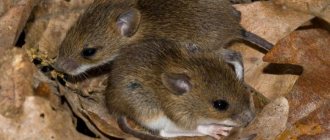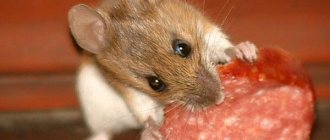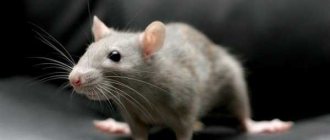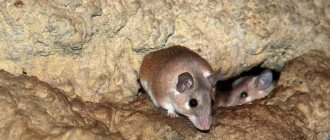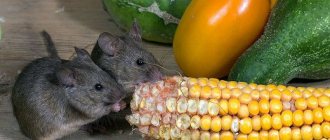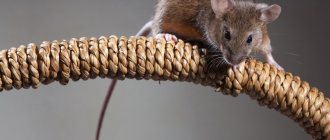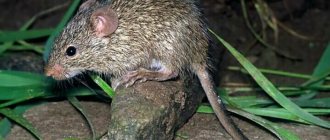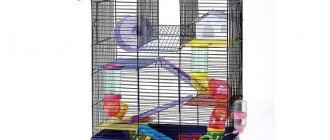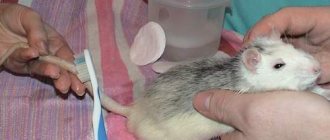Not only breeders, but also rodent fighters need to know how mice reproduce and how long they live. Cute domestic animals and terrifying street dwellers, under favorable conditions, are able to reproduce all year round.
Only at sub-zero temperatures does the female stop estrus and the males are not interested in her. An individual gives birth to about 10 cubs at a time, and the next litter may appear 1-2 months after the previous one.
During this period, the babies grow up and are able to become fertilized themselves.
What affects the reproduction of mice
In the wild, the reproduction of a house mouse can only be affected by external factors, such as cold, hunger and other weather disasters, because a pregnant female must eat well, be warm and safe, which is impossible to create in such extreme conditions. But you shouldn’t assume that it’s easier to get offspring from rodents at home. There are a lot of nuances, without which it will not be possible to breed beautiful, ornamental animals. In order to achieve the desired result when breeding mice, you should choose the right male and female.
When selecting them, the following is assessed:
- fertility;
- color and general condition of the coat;
- body type;
- weight.
For mating, you should not choose aggressive animals, as well as females that eat their offspring. The main thing is that the couple is healthy. The female is moderately well-fed, with shiny, silky hair; her ability to produce milk is also assessed based on previous births. The male must be larger than his partner and have a dense build. His coat is beautiful, even in color and shiny.
Important! Obese mice, as a rule, cannot bear offspring for a long time, so before mating they must be kept on a special diet and their physical activity increased.
Selection, preparation, rules of use for future parents
Successful reproduction largely depends on the correct selection of a pair. All candidates are carefully assessed, analyzing:
- constitution and physique;
- fatness;
- quality of the fur coat;
- fertility if mice have already been bred.
Both the female and the male must be strong, outwardly healthy, well-fed, but not obese.
If the female has already given birth, then the best is considered the one that:
- was a wonderful mother;
- brought an average number of mice;
- had a high lactation rate.
Animals that have a history of eating their offspring or animals that suffer from excessive aggression should not be allowed into breeding.
The female can be used no more than twice during the year.
Frequent childbirth significantly undermines health, and an unrestored body is unlikely to be able to provide future offspring with everything necessary for full development. Thus, it was noticed that the cubs of females who had exhausted their strength were born weak, developed poorly and died prematurely.
Males are also used wisely: frequent mating depletes reproductive function and the mouse may simply remain unfertilized.
Before mating, animals are provided with complete feeding with a sufficient amount of vitamins (especially E) and microelements.
Obese rodents, which most often turn out to be temporarily infertile, are forced to move as much as possible, and foods rich in carbohydrates are excluded from their diet.
There should be no more than ten females per male. They can be kept all together, but it is better to place each animal in its own cage, placing the females with the male as needed at the time of estrus.
When can a mouse give birth?
Sexual maturity in female rodents occurs quickly, on the 30–35th day of existence. But at home, the first mating should occur no earlier than the 12th week of life, then the reproductive qualities of the mouse will be of better quality. Males reach sexual maturity when the testes move into the scrotum, usually at 5–7 weeks. It is this factor that indicates that the animal is ready to reproduce.
Decorative baby rats
A domestic animal is more fertile.
The female reproduces more often, and there are many babies in her brood. Interesting!
The mother eats the dead rat pups. Some living offspring will be destroyed if their population is too large. Is this what wild people do? and domestic mammals.
The appearance of domestic animals is no different from their wild relatives. The decorative little rat in the photo sometimes has eyes that blend in with the color of the skin. Albinos have such eyes.
The means to control mice and rats are different. Therefore, it is important to correctly identify the rodent. An important role in this is played by the ability to distinguish little rats from rats.
There is practically not a single person who has not encountered mice or their cousins, rats, at least once in their life. Night rattles and rustling that prevent you from falling asleep, spoiled food, chewed furniture - all this indicates the appearance of unexpected guests in your home.
Some tirelessly fight with them, showing who is boss, while others, on the contrary, deliberately bring them into their homes, taming them and making them their favorites.
However, one should not ignore the fact that both mice and rats are the source of all sorts of dangerous diseases. Therefore, it is imperative to fight them. In order to choose the right method for getting rid of rodents, you need to know what their differences are.
And if in adults the difference is obvious - rats are much larger than mice, then what little rats and mice look like remains a question for many of us.
Sexual cycle of mice
The readiness of a female to mate can be determined by the presence of estrus, the phase of which is determined by taking a smear from the genital organ. The cycle in mice is 3–9 days.
In the wild, a female can give birth up to 14 times a year. But at home, in order to get high-quality offspring, it is necessary to mate 7–9 times a year. With more frequent pregnancies, the female becomes exhausted and can give birth to weak mice that will soon die.
Important! When optimal conditions are created, rodents can give birth at any time of the year. But in order to exclude unplanned reproduction when keeping one pair of animals, they are seated in different cages and placed next to each other only for mating.
Development of little mice
Newborn babies, similar to rat pups, develop very quickly: after only two to four days the first fluff appears on their bodies, their ears open, after another two days they confidently hold their heads at a distance from the floor and stand up straight, and after another two days they begin to cut themselves teeth. Then, on the thirteenth day, the eyes open and vision clears. On the fourteenth day, they complete the development of motor functions, they can move around and eat food that adults eat. After a month, they begin to live separately from their parents, the female no longer cares about them .
If the mice are decorative, at the beginning of the first month they need to be placed in different cages according to gender, so that subsequent mouse pairs will not be blood relatives. In wild mice there is no such separation, so incest is a common occurrence among them.
How does mating happen?
Males show special interest in females during estrus. You can notice the moment when a representative of the fairer sex is ready for mating by such signs as: tranquility, characteristic arching of the back, spreading of the hind limbs. So that animals can continue the race, they are placed in the same cage. Mice can mate at any time of the day, so there is no need to choose a special moment.
After copulation, the female is placed in a separate cage. After 2 hours, she is again sent to the same male for re-covering. Next, the female mouse is observed until the expected next estrus; if it does not occur, it means that fertilization was successful.
Description of the rodent
Animals of this species are very tiny compared to rats. The body of an adult mouse reaches only 6.5-9.5 cm in length. The tail of a rodent is almost half as long as the body. It is covered with scales and small sparse hairs.
The average weight of an adult is only 12 to 30 grams. The ears are small and rounded. The color is predominantly dark, brownish-gray. On the belly, the fur is lighter and colored ash-gray or white.
Are you afraid of mice?
Very Not a drop
Habitat
The most ancient remains of a mouse were found in Western Asia, North Africa and the northern regions of India.
Traveling with people on ships, mice quickly spread throughout the world and received the status of “cosmopolitan animal.”
How is pregnancy going?
The first sign of pregnancy in a mouse, of course, will be the absence of another heat. Also, the female may change in behavior, become more aggressive or, conversely, more affectionate. Her movements will become smoother and more measured.
Did you know? The baby mouse reaches a length of only 5 cm and is rightfully considered the smallest representative of the mouse species.
Signs of toxicosis may also be observed:
- apathy;
- refusal of food;
- convulsions;
- drooping eyelids;
- dullness of fur.
In this case, you should offer the mouse more drinks and favorite foods, make the conditions in the cage and room comfortable, and eliminate all kinds of stressful situations. The room should have a comfortable humidity of up to 70% and a temperature from +18°C to +20°C. The room should be ventilated 2 times a day, but avoid drafts, which can lead to colds.
You should not pick up a pregnant female without reason. When carrying out a daily walk around the room, you need to follow safety precautions and prevent the mouse from falling from a height or coming into contact with electrical appliances; the mouse should not walk where it can meet other pets or small children, who, while playing, can harm the animal.
Normally, pregnancy in a rodent lasts from 19 to 26 days. The average number of days before birth is 22 days, it is during this period that labor should begin, so you should prepare in advance a special house for the mouse in which it will care for newborns. Throughout pregnancy, you need to ensure that your pet's diet is balanced.
Cubs
Mice are born naked, blind, deaf, with undeveloped limbs. But they have an excellent appetite, and significant changes occur daily in physical development:
- in a week they are already cute fluffy creatures;
- after 14 days, hearing appears and the eyes open;
- At 3 weeks of life, the mice crawl out of the nest and explore the space.
It is not recommended to pick up small babies, as the mouse may refuse them. But from the 20th day of life, this must be done so that the mouse grows tame. At 30 days, the offspring become independent and can be given to other hands.
Mice reproduce quickly; under comfortable conditions, the process can continue continuously. But the female spends a lot of energy on feeding the mice, pregnancy, and childbirth. Therefore, the higher the birth rate, the weaker the health of the adult.
Childbirth
Mostly, mice are born at night, from midnight to 4 am or in the evening - from 18:00 to 22:00. The process of giving birth to offspring almost always goes smoothly and easily. Its duration is approximately 120 minutes. When the female gives birth, the male can be left in the cage, he will take care of the offspring, licking and covering the newborn mice.
Find out also how to name a mouse.
But during childbirth, complications can also occur that can lead to the death of the offspring or the mouse itself, so a person who wants to breed mice needs to know what symptoms should promptly call a veterinarian:
- if contractions have lasted more than 15 minutes, but labor has not begun;
- After the birth of one mouse, more than an hour has passed, and the next cubs do not appear.
Interesting facts about animals
Regardless of size, adult rodents of both species can have a litter of more than 15 or as few as two or three cubs. On average, one litter can contain about 9 cubs.
An interesting fact is that these two types of rodents cannot interbreed. Moreover, they are enemies.
Another curious factor that distinguishes the animals from each other is that the mental abilities of rats are head and shoulders above the abilities of their smaller brothers. Scientists have discovered that they are endowed with abstract thinking, thus putting rats on the same level as us, the only creatures that have this ability.
They will never live where they are in danger; before moving in, they will definitely study the upcoming living conditions. And finally, the rat community lives according to strict laws, strictly observing the hierarchy.
Mice are endowed with intelligence to a much lesser extent. Therefore, the methods of dealing with them are simpler and less sophisticated; for example, glue traps are inexpensive, easy to use and quite effective.
Rats are quite aggressive creatures. Sensing real danger, they are ready to attack even a person. In any case, these animals are not timid. Even if they are not going to attack, they are also in no hurry to run - freezing in place, they cautiously assess the situation and wait.
Their smaller brothers are not so brave; on the contrary, they are very timid. At the slightest rustle they run wherever their eyes look.
Despite the differences, people keep both rats and mice as pets. Domestic, so-called “decorative” rodents are easily tamed, get used to humans, remember their nicknames and even follow simple commands.
Mice never interbreed with rats Mice do not shine with intelligence These pests are very prolific
Not only breeders, but also rodent fighters need to know how mice reproduce and how long they live. Cute domestic animals and terrifying street dwellers, under favorable conditions, are able to reproduce all year round.
Only at sub-zero temperatures does the female stop estrus and the males are not interested in her. An individual gives birth to about 10 cubs at a time, and the next litter may appear 1-2 months after the previous one.
During this period, the babies grow up and are able to become fertilized themselves.
Ways to fight and protect
The main difficulty in the fight against field mice is that they live in places hidden from human eyes. This means that catching or poisoning them is quite problematic. Therefore, the primary task in the fight against voles is the need to find and destroy their housing. You can do this in the following ways.
We drive mice away from the territory
First of all, you need to try to drive rodents out of the area:
- Mow tall grass, remove dry leaves and weeds. You also need to get rid of branches and piles of plant debris. All of these are great places to build burrows.
- Fruits that have fallen from the tree should not be left on the site, as they are an easily accessible source of food.
- Digging up the area can help get rid of holes and underground passages.
- To prevent rodents from damaging fruit trees, a fine mesh net is dug into the ground around the trunks. The same can be done around the perimeter of the entire site.
We use repellers
The use of special repellent devices can speed up the process of expelling voles from your territory. They are installed around the perimeter of the site and provide protection from moisture.
We use mousetraps
Ordinary mousetraps can also help in the fight against mice. Experienced gardeners recommend installing these devices on the site in early spring and late autumn, since it is at this time that mice reproduce most actively. To prevent harm to pets, mouse traps can be covered with a box; this will not stop mice in pursuit of the bait.
We use poisons
At the end of winter and beginning of spring, the use of poisons is very effective. At this time, mice are hungry and not very picky about food. Poisons are placed directly in burrows.
Benefit
For many years, house mice have been bred as laboratory specimens. One of the reasons for the mass breeding of rodents in captivity is various experiments. Decoding the genome of house mice was completed in 2002. Scientists have found that the gene is 80% identical to the human gene. The effect of new drugs is being tested on animals.
Breeders are constantly experimenting, breeding pets with original colors - red, yellow, blue, white, spotted. This cute little creature pleases the eyes of its owners and is not at all like the harmful, dangerous gray creature.
Interesting!
In the course of numerous experiments, a “dancing mouse” was obtained. Pathology in the functioning of the brain, a disorder of the motor system has led to the fact that the animals are spinning non-stop, being in one place, moving in zigzags. Singing mice were developed in China about 350 years ago. Rodents make sounds similar to crickets.
The animals are bred specifically in nurseries to be fed to other animals - snakes, lizards, hedgehogs, cats, and other predators.
The house mouse is one of the most unique, interesting, unusual creatures. There is no point in purposefully destroying animals, unless they happen to be near the house or live in an apartment.
Description of the field mouse:
- Body length no more than 12 cm, excluding tail. The thin tail makes up 70% of the body length.
- The body is oblong. The hind feet are elongated and protrude forward when running.
- Long muzzle, small round ears, oblong nose.
The fur is hard, rough, short. The colors can be different - gray, brown, ocher or beige. A straight line of black or brown shade runs along the spine. The color of the abdomen is snow-white. At the base the hairline has a dark tint. Small spots may be present on the chest.
The vole mouse has unique teeth; a pair of long incisors on the lower jaw grow throughout its life. To prevent their excessive growth, and they grow at a rate of 1-2 mm per day, the mouse is forced to continuously grind them off against hard objects.
As for weight, the average animal does not weigh more than 20 grams.
>Photo
Nutritional Features
The marks left on plastic, rubber, wood and other inedible materials give the impression that house mice are omnivores. In nature, the rodent is content with seeds. grain crops, cereals, legumes. Eats seeds of cultivated and wild plants.
A certain part of the diet is occupied by insects, worms, caterpillars, larvae, and carrion. When there is a lack of water, house mice eat the succulent parts of the plant. A rodent needs about 3 ml of liquid per day. If this rule is not followed, the animal dies from dehydration within 15 days. When there is an excess of food, rodents make food reserves for a rainy day. Occasionally they destroy birds' nests and feast on eggs and small chicks.
In a human home, the diet of mice expands significantly. Pests eat all food supplies, any products. And also soap, candles, indoor flowers, glue.
Has its own characteristics. The teeth of rodents have unusual properties. Each jaw has incisors that grow daily throughout life. The animals are forced to constantly grind them down, otherwise they will not be able to close their mouths. For this purpose, they chew hard, inedible materials - wood, plastic, foam plastic, brick, rubber and the like.
Varieties
Brownies. This is facilitated by high adaptive capacity. The animals tolerate cold and heat relatively well and adapt to any living conditions. Close proximity to humans ensures survivability - a minimum of enemies, a large amount of food. A typical representative of mice can be found outdoors and indoors. Lives in garages.
House mice are the most common experimental specimens in laboratories. Over many years of work, breeders have intentionally or unintentionally bred many different subspecies of house mice. But several have been officially identified.
House mouse classification:
- musculus – has become widespread in Poland, Northern and Eastern Europe, and parts of Russia;
- bactrianus - an interesting species of domestic mice found in Asia;
- domesticus - a heat-loving species found in Southern Europe, America, Africa, Australia;
- castaneus is another representative of Asia, only in the southeastern part.
For a long time, there was another species of house mice - Mmmolossinus. Rodents have become widespread in Japan. However, later scientists stated that this species cannot be classified as a separate type, since they obtained the animals by crossing Mmmusculus, Mmcastaneus.
Cotton swab instead of a spoon
This decision was not easy. The mother already had a bad experience of feeding newborn mice. And I wasn’t at all attracted by the prospect of feeding them from a pipette every two hours... But there was nothing to do: three little lives depended on us.
In a warm house, the mice recovered and became more active. Unfortunately, we lost one of them almost immediately: either hypothermia affected him, or he was hit by a cultivator blade, but he died a few hours later. We fed the other two with a few drops of warm milk on a cotton swab (a pipette and a syringe without a needle are not suitable for this: they release the liquid in a stream that is too strong and the mouse can choke), and put them on a warm stove overnight.
So our mice lived for more than a day on the stove, from where I took them out to feed them.
When my husband and I were getting ready to go home, the mouse question came up sharply. On the one hand, I didn’t want to take them to the city (we both work, and it was not clear how to accommodate our schedule with their frequent feedings). But, on the other hand, my mother, who remained in the village, did not have any special formulas for feeding, and they were supposed to be needed in a couple of days. And I made up my mind: we took the mice home.
Why are rats dangerous?
Rats are a disaster for all humanity. They gnaw through walls in the basements of houses, sewer pipes, damage electrical mains, and damage crops.
Rats are carriers of more than 20 infectious diseases, such as leptospirosis, plague, salmonellosis, pseudotuberculosis and others. Many are dangerously fatal to human life.
It is difficult to exterminate rats using chemicals because the animal’s body quickly adapts to the poison and develops protective immunity to toxins.
Behavior of adults
You can also distinguish mice from rats by their behavior. The mouse is very afraid of people and does not catch their eye, and in case of any threat it tries to run away very quickly. Pasyuki, on the contrary, are very angry and aggressive, and sometimes even attack people. And large individuals sometimes even gather in flocks and fight off enemies together.
Pasyuki do not get along with voles and are not in the same house or outbuildings with them at the same time. If they have already appeared, this means that all other small animals will be destroyed or move to another place.
Secluded housing
In most cases, the house mouse settles on soft soil that is not prone to drying out. To make it easier to make moves, the walls of the tunnels did not collapse. They build a hole 100 cm long. There must be an entrance and 2 emergency exits. The nest chamber is built at a distance of 30 cm from the ground surface. In winter they go deeper - up to 65 cm in depth. The diameter of the nest is about 25 cm. House mice prepare a soft bedding from twigs, leaves, moss, and all convenient materials.
House mice often inhabit ready-made burrows of voles, moles, hamsters, and other rodents. Or they build a nest under stones, in natural depressions in the ground, under a mound of leaves.
In human housing, house mice place their nests in well-protected, secluded places. Prefer to settle:
- under the floor;
- between walls;
- in the attic;
- under trash cans;
- in places where food waste accumulates;
- in the vegetable store.
To build a nest, various available, suitable materials are used: straw, pieces of fabric, twigs, hair, feathers, polystyrene foam, polyurethane foam.
Interesting!
In the wild, house mice become more active at night. During the day they hide in holes for several reasons - they do not like bright light, they are afraid of predators. Housing is designed to suit people's lifestyles. They crawl out of the shelter in complete silence.
If there is constant artificial lighting in the house, house mice are active around the clock with regular breaks. There are about 20 periods of wakefulness per day with an average duration of 30 minutes. House mice move along studied routes. They leave behind feces, urine, and food crumbs.
House mice run well and quickly respond to rustling sounds and movement. The animals are capable of reaching speeds of up to 13 km/h. They climb trees and flat surfaces, jump, and behave freely in water.
Each has its own territory. The mouse does not move far from the nest; it hunts in a designated area. Males are entitled to 1200 m², females - 900 m². During the period of strong reproduction, house mice settle in families and colonies. There is a leader - a male, several dominant females.
Interesting!
The head of the family behaves aggressively towards young males; fights for primacy between females rarely occur. They raise their offspring together and take care of proper nutrition. Weak individuals try not to show themselves to the leader and begin to become active when the “leader” falls asleep. Grown-up mice are soon kicked out of the family. They create their own hierarchy.
Living environment in the wild
The house mouse loves warmth and does not tolerate high humidity. Animals do not live in the Far North, the vastness of Antarctica, or high in the mountains. The rest of the area was explored up and down.
The house mouse likes to settle near people's houses during the warm season. With the onset of cold weather, it completely moves into human habitations, barns, warehouses, granaries, outbuildings. Seasonal migration is 3-5 km.
Mass relocation occurs under unfavorable climatic conditions. Fire, flood, drought, premature frosts contribute to the migration process. Some house mice remain to spend the winter in fields in haystacks, forest belts, and stacks. With the onset of spring, he leaves houses and apartments and moves to natural places of residence.
On a note!
In desert areas, where the air temperature is always comfortable for house mice, mass migration into human homes does not occur. Rodents live in oases year-round and stay in places with bodies of water. In rocky areas they live in walnut orchards, causing considerable damage to the owners.
